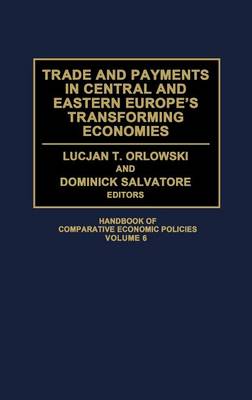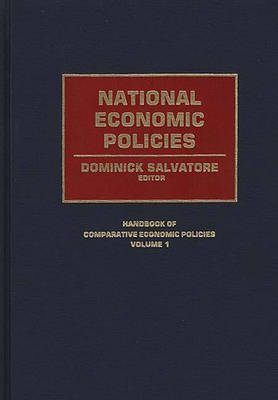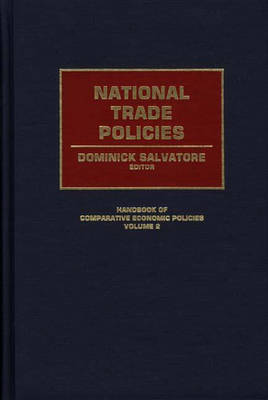Handbook of Comparative Economic Policies
5 total works
Trade and Payments in Central and Eastern Europe's Transforming Economies
by Lucjan T. Orlowski and Dominick Salvatore
This volume examines one of the major systemic changes in world economic history: the economic transformation in the Central European nations and the former Soviet states. Part I considers the dramatic adjustments in commodity structure and the geographic distribution of trade in these countries, while Part II surveys the sweeping transition of the Central and Eastern European countries' payments systems and the evolution of financial markets, exchange rates, and banking systems. Forms of integration with the global economy and proposed requirements for accession to the European Union are considered in Part III, and Part IV presents a model evaluating the record of structural adjustments in these transforming economies.
The economic transformation in Central and Eastern Europe has been one of the major systemic changes in world economic history. This volume examines the dramatic changes in trade and payment systems in Central European nations and the former Soviet states during the first half of the 1990s. Part I considers the dramatic adjustments in commodity structure and the geographic distribution of trade in these countries, while Part II surveys the sweeping transition of the Central and Eastern European countries' payments systems and the evolution of financial markets, exchange rates, and banking systems. Forms of integration with the global economy and proposed requirements for accession to the European Union are considered in Part III, and Part IV presents a model evaluating the record of structural adjustments in these transforming economies.
The main objective of this volume is to thoroughly cover the latest research advances in international trade and payments among these transforming economies. Written by noted authorities from prominent research centers, the chapters have a predominantly survey character and are supported by sound empirical evidence. Combining empirical research with policy evaluation and recommendations, this volume will serve as a resource for further studies on the economic transformation of the former Soviet bloc countries.
Macroeconomic Policy in Open Economies
by Michelle Fratianni, Juergen Von Hagen, and Dominick Salvatore
Focusing on the international dimension of macroeconomic policy, this handbook covers the main areas of modern macroeconomic policy in open economies. The emphasis is on policy applications rather than the development of economic theory. There are three basic goals: (1) an understanding of how economic theories affect actual policy making, (2) a description of the institutional and conceptual development of the international economy, and (3) an explanation of the way policy-making institutions deal with the so-called international economy.
The handbook consists of an introductory chapter and four parts. The first treats macroeconomic policy-making from the home country versus the rest of the world perspective. The second part stresses policies among interacting and reacting countries. The third part considers the development of world capital markets and the international monetary system as important parts of the policy environment. The final part details macroeconomic policies in the G7 and Latin American countries.
Monetary Policy in Developed Economies
by Michelle Fratianni and Dominick Salvatore
The third volume in Greenwood's Handbook of Comparative Economic Policies, this volume provides an overview and comparison of monetary policies in the United States and the world's leading industrial, or G-7, countries. Although monetary policy is one of the most powerful and frequently used means of combating inflation and unemployment and of promoting long-term economic growth, there are many unresolved questions pertaining to the theory and practice of monetary policy. Moreover, in a world becoming increasingly interdependent, monetary policies in each industrial country have significant repercussions in other countries. This handbook is the only in-depth, up-to-date book providing an exhaustive comparative overview of the theory and practice of monetary policy in developed economies.
Following an introduction written by the editors, the volume is divided into three parts. Part I, encompassing 5 chapters, covers the major issues in the theory and practice of monetary policy, including monetary policy and the money supply process, monetary policy and economic activity, monetary policy and inflation, monetary policy and regulation, and monetary policy and bank regulation. Part II, comprised of two chapters, deals with monetary policy in the United States, and part III includes chapters examining monetary policy in each of the other G-7 countries. A final chapter discusses monetary policy coordination in the European Monetary System. The chapters are written by well-known experts in the field of monetary economics. Chapter references and a selected bibliography identify the most important sources of additional information. The work concludes with a selected bibliography and an index.
With increased economic competition among industrial countries, the need for rapid economic development in less developed countries, and the collapse of centrally planned regimes in Eastern Europe, concern for economic policies has moved to the forefront of most nations' agendas. This reference handbook offers and overview of economic policies in the world's most important countries and regions, examining the different mix of methods and tools these governments use to achieve their economic goals. The aim of the volume is to identify and compare the various policies and instruments used by the different countries, as well as the results that have been obtained.
The work begins with a brief introduction to national economic policies, written by editor Dominick Salvatore. Separate chapters then focus on each of the major countries--the United States, Japan, India, the Soviet Union, and China--and on several homogeneous groupings of countries, such as the European Economic Community, Latin America, Africa, and Eastern Europe. Economic policies of the past decade and the important changes that have taken place in that period are explained--as well as prospects for the future. Among the major issues discussed are fiscal policies, monetary policies, industrial policies, trade and exchange rate policies, and environmental policies. By considering these various approaches from country to country and by examining the instruments utilized and the outcomes adopted, the book presents a unique comparative study of economic systems. This work will be especially useful to professional economists and policy makers, as well as to students in international economics.
International trade is now almost universally regarded as an important stimulus to growth and economic development, but while many aspects of international trade are regulated by international agreement, most nations retain some important specific trade policies for manufactured goods. In this work, the second volume of Greenwood's Handbook of Comparative Economic Policies, Dominick Salvatore presents an overview of national trade policies in the world's most important countries. As the only detailed comparative study of international trade policies, this volume will be an increasingly useful reference tool as international trade becomes more and more important in the years to come.
The work brings together contributions on twenty-two different countries plus four chapters on overall trade policies and helps to shed light not only on each nation's specific trade policies but also on the effect of various policies on the growth of developed countries, the rate of economic development, and the progress of restructuring in the former centrally planned economies. The book is divided into six basic sections: the first provides an introduction to international trade policies and tariff and trade agreements, while the remaining five sections detail leading industrial countries, other industrial countries, Latin American nations, the countries of Asia and Africa, and the USSR, Poland, and China. Each chapter within these sections offers an easily accessible overview of trade policies as well as a list of references that identify the most important sources of additional information. This handbook will be an effective resource and reference tool for students of comparative economics and for economists and international policymakers.




